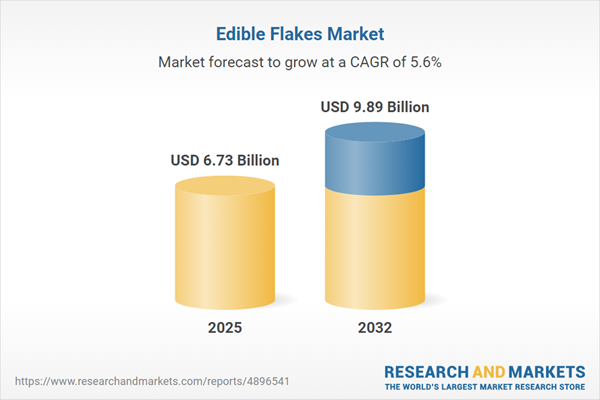Speak directly to the analyst to clarify any post sales queries you may have.
Senior decision-makers seeking to optimize opportunities in the edible flakes market must manage changing consumer expectations, rising competitive pressures, and complex supply chain requirements. Keeping pace with these shifts requires a fact-based view of the market, emerging risks, and actionable opportunities.
Market Snapshot: Edible Flakes Market Growth and Forecast
The edible flakes market is projected for sustained growth, advancing from USD 6.38 billion in 2024 to USD 6.73 billion in 2025, and reaching USD 9.89 billion by 2032 at a CAGR of 5.64%. This growth reflects strong global demand for convenient and nutrient-focused products, along with expansion into new distribution channels and applications. Both established and emerging firms are leveraging the rising adoption of digital retail, evolving their portfolios to address growing nutritional awareness and consumer accessibility. The market’s reach across developed and emerging economies signals a readiness for ongoing innovation and adaptation.
Scope & Segmentation of the Edible Flakes Market
- Product Types: The market features corn flakes, multi grain flakes, several oat varieties such as instant and rolled oats, rice flakes in both flattened and puffed forms, and wheat flakes. These products appeal to a wide range of consumer preferences and facilitate diverse uses in households and professional foodservice environments.
- Distribution Channels: Sales occur across convenience stores, specialty outlets, supermarkets, hypermarkets, and online retail. This integration allows companies to respond efficiently to modern shopping behaviors, supporting both direct-to-consumer initiatives and partnerships with e-commerce entities.
- End Uses: Applications include breakfast cereals tailored to different demographics, fortified or sugar-free options, bakery products, snack foods, and animal feed, highlighting the market’s adaptability to changing consumption patterns.
- Flavors: Varieties span chocolate, fruit including berry and tropical, savory, and plain. Offering a range of flavors helps brands address distinct regional and segment-specific preferences in both retail and foodservice sectors.
- Ingredient Types: Options range from mineral- and vitamin-fortified flakes with added B vitamins and vitamin D, to clean-label and natural products. This enables companies to stay aligned with nutrition and dietary trends as well as regulatory expectations.
- Key Regions: Coverage includes the Americas, Europe, Middle East and Africa, and Asia-Pacific. Each region brings its own regulatory landscape and consumption patterns, shaping local strategies and influencing competitive approaches from markets like the United States and Canada to China, India, and new Asia-Pacific economies.
- Leading Companies: Industry leaders include Kellogg Company, General Mills, Nestlé S.A., Post Holdings, PepsiCo, Mondelēz International, Conagra Brands, The Kraft Heinz Company, Grupo Bimbo, and Associated British Foods. Their focus remains on research and development and strengthening global distribution.
Key Takeaways for Senior Decision-Makers
- Health-driven product development is rising, driven by demand for allergen-friendly, protein-rich, and non-GMO flakes that serve evolving wellness preferences and consumer demographics.
- Modern processing technologies are widening the applications of edible flakes, integrating them into snack and bakery segments to support broader product portfolio strategies.
- Digital transformation is shifting how brands approach the market, with urban and younger consumers gravitating toward online and direct-to-consumer sales for greater convenience and tailored experiences.
- Sustainable sourcing and responsible packaging practices are now core to procurement strategies, ensuring companies meet both regulatory requirements and rising transparency expectations in the supply chain.
- Collaborative partnerships and modernized supply chains help brands stay agile, manage disruptions, and respond to regional regulatory or logistical shifts efficiently.
- Localization strategies for flavor and ingredient selection enhance brand relevance and support category differentiation in priority markets, promoting ongoing consumer engagement.
Tariff Impact: Navigating 2025 U.S. Trade Measures
Upcoming tariffs on U.S. imports will increase the cost of primary grains and packaging inputs. In response, edible flakes manufacturers are focusing more on local sourcing and forming stronger partnerships with domestic material suppliers. Large companies with integrated supply chains can better navigate these disruptions. Smaller businesses may offset risks and cost volatility by collaborating on infrastructure and procurement.
Methodology & Data Sources
This report is informed by direct interviews with industry stakeholders, complemented by a structured review of secondary market research and benchmarking across the food ingredients segment. All insights are cross-validated through peer review ensuring their reliability and practical relevance for executive decision-making.
Why This Report Matters
- Delivers actionable, evidence-based guidance for leadership teams striving to refine strategies and drive innovation throughout product offerings and distribution channels.
- Supports risk management by anticipating market reactions to global trade developments, regulatory changes, and evolving consumer preferences in edible flakes.
- Provides executives with tailored recommendations to strengthen sustainability initiatives, bolster supply chain efficiency, and enhance competitive agility.
Conclusion
Leveraging insights from this report enables senior leaders to confidently navigate market evolution, strengthen competitive positioning, and address region-specific operational demands in the edible flakes sector.
Additional Product Information:
- Purchase of this report includes 1 year online access with quarterly updates.
- This report can be updated on request. Please contact our Customer Experience team using the Ask a Question widget on our website.
Table of Contents
3. Executive Summary
4. Market Overview
7. Cumulative Impact of Artificial Intelligence 2025
Companies Mentioned
The companies profiled in this Edible Flakes market report include:- Kellogg Company
- General Mills, Inc.
- Nestlé S.A.
- Post Holdings, Inc.
- PepsiCo, Inc.
- Mondelēz International, Inc.
- Conagra Brands, Inc.
- The Kraft Heinz Company
- Grupo Bimbo, S.A.B. de C.V.
- Associated British Foods plc
Table Information
| Report Attribute | Details |
|---|---|
| No. of Pages | 183 |
| Published | October 2025 |
| Forecast Period | 2025 - 2032 |
| Estimated Market Value ( USD | $ 6.73 Billion |
| Forecasted Market Value ( USD | $ 9.89 Billion |
| Compound Annual Growth Rate | 5.6% |
| Regions Covered | Global |
| No. of Companies Mentioned | 11 |









